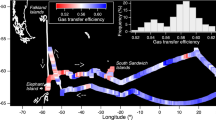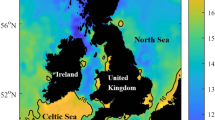Abstract
Thirteen vertical profiles of 226Ra and 222Rn in the near-surface water were obtained in the western North Pacific in winter, and the gas transfer velocities across the air-sea interface were estimated. The transfer velocities found by applying a steady state model varied widely from 2.1 to 30.2 m day−1 with a mean of 9.4 m day−1. The mean value is almost 5 times higher than that in summer in other oceans, and the maximum value is a record high for world oceans. This is partly due to the inadequacy of the steady state model, which overestimates when stronger winds blow in more recent days than the 222Rn half-life of about 4 days. In fact, a strong low pressure zone passed through the station about 2 days earlier, which was one of the low pressure zones that with a period of develop once a week or so in the northwestern North Pacific in winter. Instead of steady-state removal, if half of the radon removal occurred sporadically every 7 days, and the last removal took place two days before the observation, the transfer velocity would be 26 m day−1. Our mean transfer velocity, which is less than 20% different from the steady state value including both overestimated and underestimated values, 9.4 ± 4.8 m day−1, seems to represent the mean state of this region in winter. This suggests that the gas exchange fluxes under extremely rough conditions in the open ocean are larger than those estimated by using a transfer velocity equation with a linear or quadratic relationship with wind speed.
Similar content being viewed by others
References
Bates, N. R., A. H. Knap and A. F. Michaels (1998): Contribution of hurricanes to local and global estimates of air-sea exchange of CO2. Nature, 395, 58–61.
Broecker, W. S. (1965): An application of natural radon to problems in ocean circulation. p. 116–145. In Symposium on Diffusion in Ocean and Fresh Waters, Lamont-Doherty Geological Observatory, Palisades, New York.
Broecker, W. S. and T.-H. Peng (1984): Gas exchange measurements in natural systems. p. 479–493. In Gas Transfer at Water Surfaces, ed. by W. Brutsaert and G. H. Jirka, Reidel, Dordrecht.
Chung, Y. and H. Craig (1980): 226Ra in the Pacific Ocean. Earth Planet Sci. Lett., 49, 267–292.
Gyakum, J. R., J. R. Anderson, R.H. Grumm and E. L. Gruner (1989): North Pacific cold-season surface cyclone activity: 1975-1983. Mon. Wea. Rev., 111, 1137–1155.
Jahne, B., K. O. Munnich, R. Bosinger, A. Dutzi, W. Huber and P. Libner (1987): On the parameters influencing air-water gas exchange. J. Geophys. Res., 92(C2), 1937–1949.
Key, R. M., R. L. Brewer, J. H. Stockwell, N. L. Guinasso, Jr. and D. R. Schink (1979): Some improved techniques for measuring radon and radium in marine sediments and in seawater. Mar. Chem., 7, 251–264.
Liss, P. S. and L. Merlivat (1986): Air-sea gas exchange rates: Introduction and synthesis. The Role of Air-Sea Exchange in Geochemical Cycling, 113–127.
Liss, P. S. and P. G. Slater (1974): Flux of gases across the air-sea interface. Nature, 247, 181–184.
McDowell, W. J. and B. L. McDowell (1994): Liquid Scintillation Alpha Spectrometry. CRC Press, Inc., Florida, 184 pp.
McGillis, W. R., J. B. Edson, J. D. Ware, J. W. H. Dacey, J. E. Hare, C. W. Fairall and R. Wanninkhof (2001): Carbon dioxide flux techniques performed during GasEx-98. Mar. Chem., 75, 267–280.
Nakayama, N., S. Watanabe and S. Tsunogai (2000): Difference in O2 and CO2 gas transfer velocities in Funka Bay. Mar. Chem., 72, 115–129.
Nakayama, N., S. Watanabe and S. Tsunogai (2002): Nitrogen, oxygen and argon dissolved in the ocean water. J. Oceanogr., 58, 775–785.
Peng, T.-H., T. Takahashi and W. S. Broecker (1974): Surface radon measurements in the North Pacific Ocean Station Papa. J. Geophys. Res., 79(12), 1772–1780.
Peng, T.-H., W. S. Broecker, G. G. Mathieu and Y.-H. Li (1979): Radon evasion rates in the Atlantic and Pacific Oceans as determined during the Geosecs program. J. Geophys. Res., 84(C5), 2471–2486.
Roether, W. (1986): Field measurements of gas exchange. p. 117–128. In Dynamic Processes in the Chemistry of the Upper Ocean, ed. by J. D. Burton, P. G. Brewer and R. Chesselet, Plenum, New York.
Sarmiento, J. L., D. E. Hammond and W. S. Broecker (1976): The calculation of statistical counting error for 222Rn scintillation counting. Earth Planet Sci. Lett., 32, 351–356.
Siegenthaler, U. and J. L. Sarmiento (1993): Atmospheric carbon dioxide and the ocean. Nature, 365, 119–125.
Smethie, W. M., Jr., T. Takahashi, D. W. Chipman and J. R. Ledwell (1985): Gas exchange and CO2 flux in the tropical Atlantic Ocean determined from 222Rn and pCO2 measurements. J. Geophys. Res., 90(C4), 7005–7022.
Tans, P. P., I. Y. Fung and T. Takahashi (1990): Observational constraints on the global CO2 budget. Science, 247, 1431-1438.
Tsunogai, S. and N. Tanaka (1980): Flux of oxygen across the air-sea interface as determined by the analysis of dissolved components in sea water. Geochem. J., 14, 227–234.
Wallace, D. W. R. and C. D. Wirick (1992): Large air-sea gas fluxes associated with breaking waves. Nature, 356, 694-696.
Wanninkhof, R. (1992): Relationship between wind speed and gas exchange over the ocean. J. Geophys. Res., 97(C5), 7373–7382.
Wanninkhof, R. and W. R. McGillis (1999): A cubic relationship between air-sea CO2 exchange and wind speed. Geophys. Res. Lett., 26, 1889–1892.
Watson, A. J., R. C. Upstill-Goddard and P. S. Liss (1991): Airsea gas exchange in rough and stormy seas measured by a dual-tracer technique. Nature, 349, 145–147.
Author information
Authors and Affiliations
Rights and permissions
About this article
Cite this article
Kawabata, H., Narita, H., Harada, K. et al. Air-Sea Gas Transfer Velocity in Stormy Winter Estimated from Radon Deficiency. Journal of Oceanography 59, 651–661 (2003). https://doi.org/10.1023/B:JOCE.0000009594.49463.1c
Issue Date:
DOI: https://doi.org/10.1023/B:JOCE.0000009594.49463.1c




